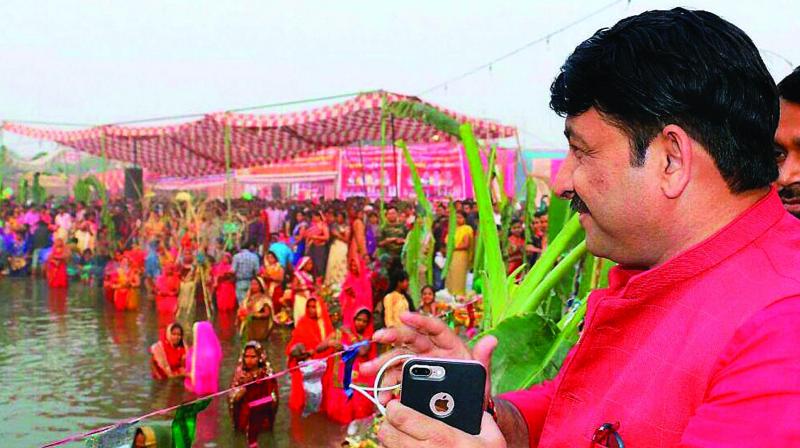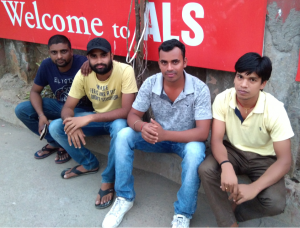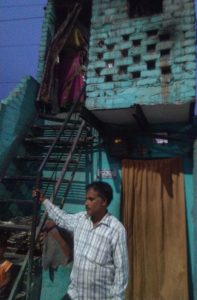
From IAS aspirants to labourers, how Purvanchalis became Delhi’s big vote bank

Looking at his mobile phone, Raja is smiling at a YouTube video of BJP Delhi chief and MP Manoj Tiwari – the saffron party’s face of Purvanchali migrants in the national capital.
In the video, Tiwari, addressing an election rally in Bihar’s Darbhanga, breaks into a song. “Noon Roti Khayenge, Modiji ko Jitayenge, Theek Hai? (Will live on a frugal meal of salt and roti but will bring Modiji back. Okay?),” Tiwari, who also happens to be a famous Bhojpuri singer-actor, asks the audience for approval. The crowd chants, ‘Modi, Modi.’ Raja breaks into a hearty laughter and pauses the video to answer a query about Tiwari. “Manoj Tiwari represents the Purvanchalis here but his heart is with the Delhiites,” he says.
Amid the melee of migrants in Delhi, Raja is among the swelling political clout of Purvanchali voters that is being eyed by all parties. Delhi has around 1.36 crore voters out of its over 2 crore population. According to various media reports, Purvanchalis — natives of Bihar and eastern Uttar Pradesh — make nearly one-third of the city’s population. Of these, the biggest chunk belongs to north Bihar.
Purvanchali paradigm
Over the years, the Purvanchali vote bank has assumed a huge significance in deciding the fate of candidates across Delhi.
Tiwari, a native of Atarwalia village in Bihar’s Kaimur district, is seeking a re-election from the Northeast Delhi constituency in a three-cornered fight among the BJP, Congress heavyweight Sheila Dikshit and Aam Aadmi Party (AAP)’s Dilip Pandey, who hails from Zamania in eastern UP. Both Tiwari and Pandey will be competing for the Purvanchali votes – a factor that the Congress is hoping to go in favour of Dikshit, the darling of Delhi who hails from Punjab but is also famous as the bahu (daughter-in-law) of Uttar Pradesh.
The BJP, after paying a price for overlooking the Purvanchali sentiments in the last Delhi Assembly elections, shifted its focus back on them by making Tiwari the state party president ahead of the municipal polls. It also gave a considerable number of tickets to Purvanchalis, earlier a Congress vote bank that had turned to Arvind Kejriwal’s AAP in the 2015 Assembly polls after it had fielded many from the community.
What, many others say, worked in favour of the BJP in the 2017 municipal polls was the decision by the then lieutenant governor, Najeeb Jung, to declare Chhath Puja a public holiday at the behest of the saffron party. The shift in focus worked and the BJP swept the local body polls.
Tiwari, his supporters claim, emerged as a prominent face because of his direct connect with the Bihari migrants with a dedicated fan following. But the reality on the ground tells a different tale.

At Nehru Vihar’s Vardhman Plaza, famous as a coaching hub for Union Public Service Commission (UPSC) and other competitive exams, a group of Staff Selection Commission (SSC) aspirants believe there is very little they can identify with Tiwari’s brand of politics. “The biggest concern for every Purvanchali living in Delhi is employment and the party that Tiwari represents has failed to give that despite promising the moon. People don’t care whether Tiwari can win or not. Hai toh woh nachaniya gawaiya hi na (At the end of the day, he is just an entertainer),” says Amit Kumar, 26, from Sasaram. Kumar has been in Delhi preparing for competitive exams for the past six years.
Talking about the dismal job scenario, Raja says, “For instance, we have been waiting for the results of SSC Combined Graduate Level 2017 in which lakhs of students appeared. The matter is stuck in court [the exam papers were allegedly leaked, leading to huge protests from job-seekers]. Now, the notification to hold the 2018 exam from June 4 is already out. There is no clarity for those who appeared for the 2017 exams. Will there be re-examinations or not? Nobody knows. Yet, the government is not talking about jobs at all.”
According to Kumar, most migrants living in the area have their voter’s ID cards from Delhi. “During the last elections, party workers came and helped everyone get their voter IDs. Polling agents from across all parties come and do that. They know each vote counts,” he said. Many others like Kumar claim Tiwari doesn’t listen to their problems. “Tiwari had promised he would address issues like health and education for migrant workers and middle class, unfair treatment by the police and making shelters,” says another aspirant who didn’t wish to be identified.
Last year, he goes on to narrate, a group of UPSC aspirants had a fight with property dealers and house owners here over rent. Brokers were charging extra money for providing rented accommodations. When the boys complained, the property dealers allegedly dragged them into their shop and bashed them up with sticks and chappals. They were badly injured. It became a huge fight as rumour spread that an injured student died on the spot. More students joined in with each side throwing stones. The police had to come. “When our boys went to Tiwari for redressal, he didn’t do anything. Instead, he supported the Punjabis,” he says.
Residents of the area though have a different story to narrate. “These Biharis come and stay here. Some of them are well-mannered but some are goons. They often don’t pay their rent on time and if questioned they start fighting,” says a house owner in Indra Vihar. According to the women that is one reason why they prefer students from the north-eastern states. “At least they pay their rent on time.”
“Most students who come here are from villages. They all have the same dream of cracking UPSC or SSC exams. They can’t afford to pay such exorbitant rent,” says Raja.
Houses in the area are rented out to students for ₹10,000-₹20,000 a month. “How is it possible for students from poor families to afford it?” asks Raja, who says an estimated 20,000 students from various cities stay in the localities of Nehru Vihar and Mukherjee Nagar alone. Those who can’t afford to take up a room in Nehru Vihar and urban localities nearby are forced to take refuge in slums such as Gopalpur village or Wazirabad.
A world apart
Within a distance of barely a kilometre, Nehru Vihar and Gopalpur village feel like two different worlds. The road that leads to the shanties of Gopalpur runs parallel to an open sewer. Part of the ‘jhuggi jhopri’ clusters made by the Delhi Urban Shelter Improvement Board, these shanties are homes to many migrant labourers.
Standing near a vendor selling samosa and aloo tikki (potato patty), 62-year-old Amarendra Vishwas from Bihar’s Saharsa says he came to Delhi more than four decades ago. Unlike Kumar and his friends, Vishwas and other migrants in the neighbourhood represent different classes, but are chasing the same dream – of a better future.

The men here mostly work as cart-pullers, vendors, auto-rickshaw drivers in the day. By evening, most of them turn into drunkards. Najma Begum, who runs a small chicken shop, says: “This is not a woman’s job but I’m forced to do it. Kya kare, mera aadmi nashedi jo hai (my husband is a drunkard).” Najma is a Purvanchali from Uttar Pradesh. According to an old man and his wife sitting outside their house, it’s the nature of their work that forces most labourers to take refuge in alcohol.
Ask them about the coming elections in Delhi and they hesitatingly ask, “Who do you want us to vote for?”
In Gopalpur, almost everyone maintains a cagey silence about elections.
After a while, the old man speaks. “Jhadu [the party symbol of AAP] will win from here. Usi ne yeh mahal bana ke diya hai,” he points at his shanty, saying ‘jhadu’ has made it possible for him to have a roof over his head. “The BJP has done nothing for us.” As an afterthought, he adds that Modiji is a good man. “He has worked a lot for the country but Manoj Tiwari doesn’t talk to us.” Just as he opens his mouth to say his name, his wife stops him. “Why do you want to know our names? To tell you the truth, all parties are good, they all work for the poor people. We all will decide about our votes later,” she says.
Everybody loves the migrant vote
Back in 2015, the Aam Aadmi Party emerged as a major contender for Purvanchali voters. Its candidate Dilip Pandey, many in the area maintain, has worked hard to build a ‘personal rapport’ with the people. They also swear by his etiquette and accessibility.
According to most residents, including Purvanchalis, Arvind Kejriwal’s cheap electricity and water have made a major difference in their lives. “People love jhadu but this election is about Modi and Congress. Either we give complete mandate to the opposition or vote for Modi. No point, voting for a party that won’t get majority. Who wants another election in two years?” Kumar argues. He, however, maintains that Sheila Dikshit is a strong contender and enjoys considerable clout among all and sundry. “Students like us feel she has done a good job in her previous stints. The Metro that we travel by, the flyovers that we see were all made by her.”
Back at GTB Metro station, Praveen, who runs a bookshop at the Kingsway Camp, says, “I had come to Delhi to become an officer but life had some other plans.” Today, Praveen has his own two-room flat in Delhi and a car. Talking about the elections, he says even though traders like him are unhappy with Goods and Services Tax and the sealing drive, Modi hasn’t lost his popularity. “The prime minister has brought a new ‘josh’ [enthusiasm] among people. He is the only one who has the courage to tell Pakistan to keep at bay or we’ll push the nuclear button. So, it doesn’t matter if migrants like me get a Purvanchali as our MP or not. What people know is their votes will go to Modi not Manoj Tiwari.”
Raja begs to differ on that and says, “At least I’m not happy with the BJP government. I’m struggling for a job and if my government can’t keep its promise why should one vote for Manoj Tiwari, even if he is a Purvanchali?”
As if to further dismiss Tiwari’s importance in the elections, Raja says, “By the way, that song — Noon Roti Khayenge, Modiji Ko Jitayenge — is not by Manoj Tiwari. It’s a ‘remix’ of Khesari Lal Yadav’s hit number.”
Khesari Lal is a rising Bhojpuri singer-actor to whom Manoj Tiwari and stalwarts of his times lost their fans long back. “Manoj Tiwari has passed his prime, theek hai?” says Raja. Of course, he meant in the Bhojpuri entertainment industry.


